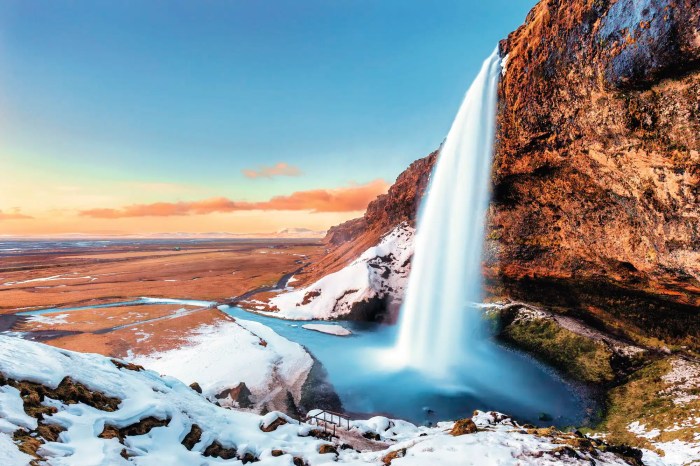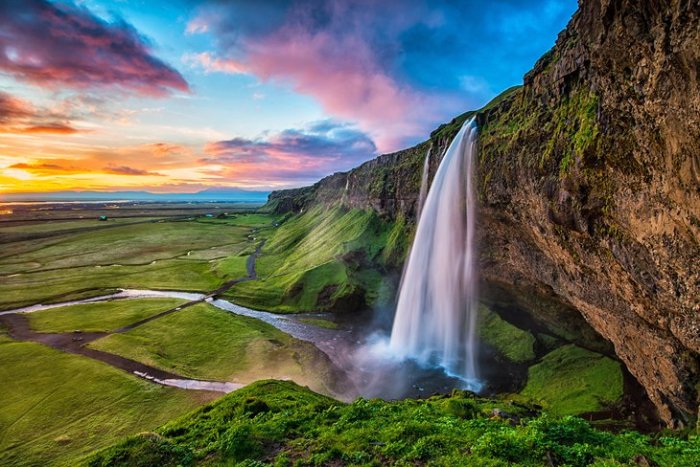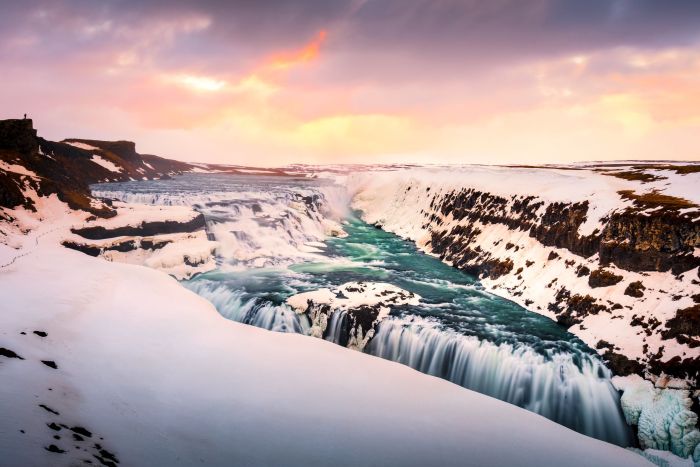Planning a trip to Iceland, the land of breathtaking natural beauty, can be an exhilarating experience. To make the most of your journey, it’s crucial to choose the best time to visit Iceland, taking into account the unique characteristics of each season. This guide will navigate you through the intricacies of Iceland’s weather, seasons, activities, and travel considerations, empowering you to tailor your trip to your preferences and create unforgettable memories.
Iceland’s diverse seasons offer a kaleidoscope of experiences, from the ethereal glow of the Northern Lights to the vibrant hues of summer wildflowers. Whether you seek adventure amidst glaciers and volcanoes or tranquility in geothermal lagoons, understanding the seasonal variations will help you plan an itinerary that aligns with your aspirations.
Weather
Iceland’s weather is renowned for its variability and unpredictability, often changing rapidly throughout the day. The country experiences four distinct seasons, each with its unique weather patterns.
In general, Iceland has mild temperatures year-round, thanks to the warming influence of the Gulf Stream. However, the weather can be highly influenced by the country’s location at the edge of the Arctic Circle and the prevailing westerly winds.
Monthly Weather Patterns
The following table provides an overview of the average temperature, precipitation, and daylight hours for each month in Iceland:
| Month | Average Temperature (°C) | Average Precipitation (mm) | Average Daylight Hours |
|---|---|---|---|
| January | 0.5 | 60 | 5 |
| February | 1.5 | 55 | 7 |
| March | 2.5 | 50 | 10 |
| April | 5.0 | 45 | 14 |
| May | 9.0 | 40 | 18 |
| June | 12.0 | 35 | 21 |
| July | 13.5 | 30 | 20 |
| August | 12.5 | 35 | 17 |
| September | 9.0 | 40 | 14 |
| October | 5.5 | 45 | 10 |
| November | 2.5 | 50 | 7 |
| December | 1.0 | 60 | 5 |
The winter months (November to April) are generally cold and dark, with frequent precipitation in the form of rain or snow. Temperatures can drop below freezing, especially in the interior and mountainous areas. Winter storms can also bring strong winds and heavy snowfall, which can impact travel and outdoor activities.
The summer months (May to September) are milder and brighter, with longer daylight hours. Temperatures typically range from 10°C to 15°C, although they can occasionally reach 20°C or higher. The weather during this time is generally more stable, with less precipitation and fewer storms. However, it is not uncommon to experience sudden changes in weather, such as rain or fog, even during the summer months.
Weather Impact on Outdoor Activities and Travel
Iceland’s weather conditions can significantly impact outdoor activities and travel plans. During the winter months, extreme cold and snow can make it challenging to participate in certain activities, such as hiking or camping. Winter storms can also lead to road closures and flight cancellations.
If you’re planning a trip to Iceland, be sure to consider the best time to visit. The summer months offer long days and warm temperatures, perfect for hiking and exploring the country’s stunning natural beauty. However, if you’re looking for a more adventurous experience, consider visiting in the shoulder seasons (spring or fall) when the weather is still mild but the crowds are smaller.
And if you’re a serious hiker, be sure to check out the best hiking trails in the US for an unforgettable experience. But no matter when you visit, Iceland is sure to leave you with lasting memories.
In contrast, the summer months provide more favorable conditions for outdoor activities. The longer daylight hours and milder temperatures allow for extended exploration and enjoyment of Iceland’s natural beauty. However, it is important to be prepared for sudden changes in weather, especially when venturing into remote areas.
Seasons: Best Time To Visit Iceland

Iceland experiences distinct seasons, each with its own unique characteristics and offerings for visitors. Understanding these seasons can help you plan your trip to align with your interests and preferences.
The four seasons in Iceland are:
- Spring (March-May): Characterized by milder temperatures, increased daylight hours, and the arrival of migratory birds.
- Summer (June-August): The warmest and brightest season, with near-24-hour daylight and opportunities for outdoor activities.
- Autumn (September-November): Known for its vibrant fall foliage, cooler temperatures, and increased precipitation.
- Winter (December-February): The coldest and darkest season, with shorter daylight hours and potential for snow and ice.
Pros and Cons of Visiting Iceland in Each Season
Each season in Iceland offers its own advantages and drawbacks. Here’s a brief overview:
| Season | Pros | Cons |
|---|---|---|
| Spring | – Milder temperatures – Increased daylight hours – Migratory birdwatching opportunities |
– Can be unpredictable weather – Some attractions may not be fully open |
| Summer | – Warmest and brightest season – Near-24-hour daylight – Ideal for outdoor activities |
– Crowded with tourists – Prices may be higher |
| Autumn | – Vibrant fall foliage – Cooler temperatures – Fewer crowds |
– Increased precipitation – Some attractions may close earlier |
| Winter | – Unique winter landscapes – Northern Lights viewing opportunities – Lower prices |
– Cold and dark – Limited daylight hours – Some roads may be closed |
Key Attractions and Activities by Season, Best time to visit iceland
The availability of attractions and activities in Iceland varies depending on the season. Here’s a table summarizing what you can expect in each season:
| Season | Key Attractions | Activities |
|---|---|---|
| Spring | – Gullfoss Waterfall – Þingvellir National Park – Snæfellsjökull National Park |
– Hiking – Wildlife watching – Whale watching |
| Summer | – Vatnajökull National Park – Blue Lagoon – Landmannalaugar |
– Hiking – Camping – Swimming – Horseback riding |
| Autumn | – Jökulsárlón Glacier Lagoon – Diamond Beach – Snæfellsnes Peninsula |
– Hiking – Wildlife watching – Northern Lights viewing |
| Winter | – Northern Lights – Ice caves – Dog sledding |
– Northern Lights viewing – Ice caving – Skiing – Snowmobiling |
Northern Lights
The Northern Lights, also known as Aurora Borealis, are a natural light display in the sky, primarily visible at high-latitude regions (around the Arctic and Antarctic). They are caused by the interaction of charged particles from the solar wind with the Earth’s atmosphere.
In Iceland, the Northern Lights are visible during the winter months, from September to April. The best time to see them is typically between October and March, when the nights are longest and the sky is darkest.
Best Months and Locations for Viewing the Northern Lights
The following table indicates the best months and locations for viewing the Northern Lights in Iceland:
| Month | Best Locations |
|---|---|
| September | Reykjavik, Akureyri, Vik |
| October | Reykjavik, Akureyri, Vik, Snæfellsnes Peninsula |
| November | Reykjavik, Akureyri, Vik, Snæfellsnes Peninsula, Westfjords |
| December | Reykjavik, Akureyri, Vik, Snæfellsnes Peninsula, Westfjords, North Iceland |
| January | Reykjavik, Akureyri, Vik, Snæfellsnes Peninsula, Westfjords, North Iceland, East Iceland |
| February | Reykjavik, Akureyri, Vik, Snæfellsnes Peninsula, Westfjords, North Iceland, East Iceland, South Iceland |
| March | Reykjavik, Akureyri, Vik, Snæfellsnes Peninsula, Westfjords, North Iceland, East Iceland, South Iceland |
| April | Reykjavik, Akureyri, Vik, Snæfellsnes Peninsula, Westfjords |
Factors Influencing Visibility and Intensity
The visibility and intensity of the Northern Lights are influenced by several factors, including:
- Solar activity: The Northern Lights are caused by solar wind, so their intensity is directly related to the level of solar activity. Solar activity is highest during the peak of the solar cycle, which occurs every 11 years.
- Cloud cover: Clouds can block the view of the Northern Lights, so it is important to have clear skies for optimal viewing.
- Light pollution: Light pollution from cities and towns can make it difficult to see the Northern Lights. It is best to travel to remote areas with minimal light pollution for the best viewing experience.
- Moon phase: The moon’s brightness can also affect the visibility of the Northern Lights. It is best to view the Northern Lights during a new moon, when the sky is darkest.
Activities

Iceland offers a diverse range of activities and attractions throughout the year, catering to every traveler’s interests. From exploring glaciers to witnessing the Northern Lights, there is always something to experience, regardless of the season.
Summer (June to August) is generally regarded as the ideal time to visit Iceland, as it offers long daylight hours and mild temperatures. However, if you prefer to avoid crowds and experience the Northern Lights, consider visiting in the winter months.
While in Iceland, don’t miss the opportunity to explore alcudia , a charming town known for its beautiful beaches and historic landmarks. After your detour, plan your return to Iceland during the shoulder seasons (May or September) for a balance of pleasant weather and fewer tourists.
To help plan your Icelandic adventure, here is a categorization of popular activities based on season, along with a table comparing their availability and accessibility:
Summer (June – August)
- Hiking: Explore Iceland’s stunning landscapes on well-maintained trails, ranging from easy to challenging.
- Whale watching: Embark on a boat tour to witness majestic whales in their natural habitat.
- Puffin watching: Visit puffin colonies and observe these adorable birds up close.
- White-water rafting: Experience the thrill of navigating Iceland’s powerful rivers.
- Camping: Pitch a tent under the midnight sun and enjoy the unique Icelandic wilderness.
Autumn (September – November)
- Northern Lights viewing: As the nights get longer, the chances of witnessing the Aurora Borealis increase.
- Hiking: Enjoy the vibrant autumn colors while exploring Iceland’s trails.
- Horseback riding: Embark on a scenic ride through Iceland’s countryside.
- Photography: Capture the breathtaking landscapes and wildlife in their autumnal splendor.
- Visiting geothermal pools: Relax and rejuvenate in Iceland’s natural hot springs.
Winter (December – February)
- Northern Lights viewing: Winter offers the best conditions for witnessing the Aurora Borealis.
- Ice caving: Explore the enchanting interiors of Iceland’s glaciers.
- Snowmobiling: Traverse Iceland’s snowy landscapes on a thrilling snowmobile adventure.
- Dog sledding: Experience the exhilaration of being pulled through the snow by a team of huskies.
- Cross-country skiing: Glide through Iceland’s winter wonderland on skis.
Spring (March – May)
- Hiking: Enjoy the awakening of nature as Iceland’s landscapes come to life.
- Birdwatching: Observe the arrival of migratory birds and witness the nesting season.
- Whale watching: Spot whales as they return to Iceland’s coastal waters.
- Kayaking: Explore Iceland’s fjords and coastline from a unique perspective.
- Visiting waterfalls: Witness the increased water flow and dramatic power of Iceland’s waterfalls.
| Activity | Summer | Autumn | Winter | Spring |
|---|---|---|---|---|
| Hiking | Yes | Yes | Limited | Yes |
| Whale watching | Yes | Yes | Limited | Yes |
| Puffin watching | Yes | Yes | No | No |
| White-water rafting | Yes | Limited | No | No |
| Camping | Yes | Limited | No | Limited |
| Northern Lights viewing | Limited | Yes | Yes | Limited |
| Horseback riding | Yes | Yes | Limited | Yes |
| Photography | Yes | Yes | Yes | Yes |
| Visiting geothermal pools | Yes | Yes | Yes | Yes |
| Ice caving | No | No | Yes | No |
| Snowmobiling | No | No | Yes | No |
| Dog sledding | No | No | Yes | No |
| Cross-country skiing | No | No | Yes | No |
| Birdwatching | Limited | Yes | Limited | Yes |
| Kayaking | Yes | Limited | No | Yes |
| Visiting waterfalls | Yes | Yes | Yes | Yes |
Travel Considerations

Navigating Iceland requires meticulous planning, encompassing transportation, accommodation, and financial considerations. Understanding these aspects will enhance your travel experience and ensure a seamless journey.
Planning a trip to Iceland? Summer offers endless daylight for exploring, while winter brings magical Northern Lights. But for a mix of both, visit in spring or fall. Like Iceland, Amsterdam also has distinct seasons. Check out the amsterdam weather before your trip to plan accordingly.
And remember, while Iceland’s weather can be unpredictable, the breathtaking landscapes make it worth the visit any time of year.
Transportation options in Iceland cater to diverse preferences. Keflavik International Airport (KEF) serves as the primary gateway, connecting Iceland to major international destinations. From KEF, travelers can access Reykjavik via the Flybus or Airport Express bus services, taking approximately 45 minutes. Alternatively, taxis and rental cars offer more flexibility, albeit at a higher cost.
Accommodation
Iceland’s accommodation options range from budget-friendly hostels to luxurious hotels. Hostels provide shared dormitory-style rooms, while guesthouses offer private rooms with shared facilities. For a more comfortable stay, hotels cater to various budgets and preferences, offering amenities such as private bathrooms, Wi-Fi, and breakfast.
Costs
Iceland is renowned for its stunning natural beauty, but it also carries a reputation for being an expensive destination. To mitigate costs, consider traveling during the off-season (September to April) when prices for flights and accommodation tend to be lower. Additionally, opting for budget-friendly accommodation, cooking meals instead of dining out, and taking advantage of free activities like hiking and visiting national parks can help reduce expenses.
Final Summary

Iceland’s allure extends beyond its stunning landscapes; it’s a place where ancient Viking sagas intertwine with modern-day wonders. By choosing the best time to visit Iceland, you’ll not only witness its natural splendor but also immerse yourself in its rich culture and history. Embrace the spirit of exploration, venture into the heart of this Nordic gem, and create an Icelandic adventure that will forever hold a special place in your heart.
Q&A
What is the best time to see the Northern Lights in Iceland?
The Northern Lights are most visible during the winter months, particularly from September to March, when the skies are darker and clearer.
What are the must-visit attractions in Iceland?
Iceland offers a wealth of natural wonders, including the Blue Lagoon, Gullfoss Waterfall, Geysir Geothermal Area, and Vatnajökull National Park.
What activities can I enjoy in Iceland year-round?
Iceland provides a range of activities throughout the year, such as hiking, glacier trekking, whale watching, and exploring ice caves.